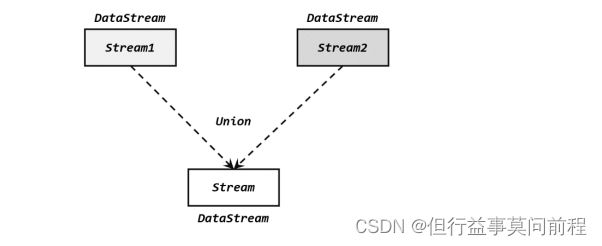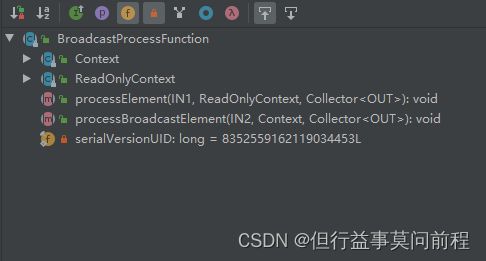flink 多流转换(侧输出流分流、Union、Connect) 实时对账app 的支付操作和第三方的支付操作的双流 Join
文章目录
- 前言
-
- 1. 分流
- 2. 合流
-
- 2.1 联合(Union)
- 2.2 连接(Connect)
-
- 2.2.1 连接流(ConnectedStreams)
- 2.2.2 CoProcessFunction
- 2.2.3 广播连接流(BroadcastConnectedStream)
- 2.2 基于时间的合流——双流联结(Join)
前言
1. 分流
将一条数据流拆分成完全独立的两条、甚至多条流,直接用处理函数(process function)的侧输出流(side output)即可

public class SplitStreamByOutputTag {
private static OutputTag<Tuple3<String, String, Long>> MaryTag = new OutputTag<Tuple3<String, String, Long>>("Mary-pv") {};
private static OutputTag<Tuple3<String, String, Long>> BobTag = new OutputTag<Tuple3<String, String, Long>>("Bob-pv") {};
public static void main(String[] args) throws Exception {
StreamExecutionEnvironment env = StreamExecutionEnvironment.getExecutionEnvironment();
env.setParallelism(1);
SingleOutputStreamOperator<Event> stream = env.addSource(new ClickSource());
SingleOutputStreamOperator<Event> processedStream = stream.process(new ProcessFunction<Event, Event>() {
@Override
public void processElement(Event value, Context ctx, Collector<Event> out) throws Exception {
if (value.user.equals("Mary")) {
ctx.output(MaryTag, new Tuple3<>(value.user, value.url, value.timestamp));
} else if (value.user.equals("Bob")) {
ctx.output(BobTag, new Tuple3<>(value.user, value.url, value.timestamp));
} else {
out.collect(value);
}
}
});
processedStream.getSideOutput(MaryTag).print("Mary pv");
processedStream.getSideOutput(BobTag).print("Bob pv");
processedStream.print("else");
env.execute();
}
}
2. 合流
2.1 联合(Union)
联合操作要求必须流中的数据类型必须相同,合并之后的新流会包括所有流中的元素,数据类型不变

stream1.union(stream2, stream3, ...)
注意:
对于合流之后的水位线,以最小的watermark为准,才可以保证所有流都不会再传来水位线之前的数据
public class UnionExample {
public static void main(String[] args) throws Exception {
StreamExecutionEnvironment env = StreamExecutionEnvironment.getExecutionEnvironment();
env.setParallelism(1);
SingleOutputStreamOperator<Event> stream1 = env.socketTextStream("192.168.0.23", 7777)
.map(data -> {
String[] field = data.split(",");
return new Event(field[0].trim(), field[1].trim(), Long.valueOf(field[2].trim()));
})
.assignTimestampsAndWatermarks(
WatermarkStrategy
.<Event>forBoundedOutOfOrderness(Duration.ofSeconds(2))
.withTimestampAssigner(new SerializableTimestampAssigner<Event>() {
@Override
public long extractTimestamp(Event element, long recordTimestamp) {
return element.timestamp;
}
})
);
stream1.print("stream1");
SingleOutputStreamOperator<Event> stream2 = env.socketTextStream("192.168.0.23", 7778)
.map(data -> {
String[] field = data.split(",");
return new Event(field[0].trim(), field[1].trim(),
Long.valueOf(field[2].trim()));
})
.assignTimestampsAndWatermarks(WatermarkStrategy
.<Event>forBoundedOutOfOrderness(Duration.ofSeconds(5))
.withTimestampAssigner(new SerializableTimestampAssigner<Event>() {
@Override
public long extractTimestamp(Event element, long
recordTimestamp) {
return element.timestamp;
}
})
);
stream2.print("stream2");
// 合并两条流
stream1.union(stream2)
.process(new ProcessFunction<Event, String>() {
@Override
public void processElement(Event value, Context ctx, Collector<String> out) throws Exception {
out.collect(" 水 位 线 : " + ctx.timerService().currentWatermark());
}
})
.print();
env.execute();
}
}
在合流之后的 ProcessFunction 对应的算子任务中,逻辑时钟的初始状态:

由于 Flink 会在流的开始处,插入一个负无穷大(Long.MIN_VALUE)的水位线,所以合流后的 ProcessFunction 对应的处理任务,会为合并的每条流保存一个分区水位线,初始值都是 Long.MIN_VALUE;而此时算子任务的水位线是所有分区水位线的最小值,因此也是Long.MIN_VALUE
2.2 连接(Connect)
2.2.1 连接流(ConnectedStreams)
DataStream 中的数据只能有唯一的类型,所以连接得到的并不是 DataStream,而是一个连接流(ConnectedStreams)连接流可以看成是两条流形式上的统一,被放在了一个同一个流中;事实上内部仍保持各自的数据形式不变,彼此之间是相互独立的。需要进一步定义一个同处理(co-process)转换操作。两条流可以保持各自的数据类型、处理方式也可以不同,不过最终会统一到同一个 DataStream 中

public class CoMapExample {
public static void main(String[] args) throws Exception {
StreamExecutionEnvironment env = StreamExecutionEnvironment.getExecutionEnvironment();
env.setParallelism(1);
DataStream<Integer> stream1 = env.fromElements(1, 2, 3);
DataStream<Long> stream2 = env.fromElements(1L, 2L, 3L);
ConnectedStreams<Integer, Long> connectedStreams = stream1.connect(stream2);
SingleOutputStreamOperator<String> map = connectedStreams.flatMap(new CoFlatMapFunction<Integer, Long, String>() {
@Override
public void flatMap1(Integer value, Collector<String> out) throws Exception {
out.collect("stream1:" + value);
}
@Override
public void flatMap2(Long value, Collector<String> out) throws Exception {
out.collect("stream2:" + value);
}
});
map.print();
env.execute();
}
}
ConnectedStreams 可直接调用.keyBy()进行按键分区的操作,传入两个参数 keySelector1和 keySelector2,是两条流中各自的键选择器,把两条流中 key 相同的数据放到一起(注意两条流定义的键的类型必须相同,否则会抛出异常)
connectedStreams.keyBy(keySelector1, keySelector2);
2.2.2 CoProcessFunction

使用CoProcessFunction方法,需要实现的就是 processElement1()、processElement2()两个方法,在每个数据到来时,会根据来源的流调用其中的一个方法进行处理。CoProcessFunction 可以通过上下文 ctx 来访问 timestamp、水位线,并通过 TimerService 注册定时器;另外提供了.onTimer()方法,用于定义定时触发的处理操作
//实时对账,app 的支付操作和第三方的支付操作的一个双流 Join。App 的支付事件和第三方的支付事件将会互相等待 5 秒钟,如果等不来对应的支付事件,那么就输出报警信息
public class BillCheckExample {
public static void main(String[] args) throws Exception {
StreamExecutionEnvironment env = StreamExecutionEnvironment.getExecutionEnvironment();
env.setParallelism(1);
// 来自 app 的支付日志
SingleOutputStreamOperator<Tuple3<String, String, Long>> appStream = env
.fromElements(Tuple3.of("order-1", "app", 1000L), Tuple3.of("order-2", "app", 2000L),Tuple3.of("order-3", "app", 9000L))
.assignTimestampsAndWatermarks(WatermarkStrategy.<Tuple3<String, String, Long>>forMonotonousTimestamps()
.withTimestampAssigner(new SerializableTimestampAssigner<Tuple3<String, String, Long>>() {
@Override
public long extractTimestamp(Tuple3<String, String, Long>
element, long recordTimestamp) {
return element.f2;
}
})
);
// 来自第三方支付平台的支付日志
SingleOutputStreamOperator<Tuple4<String, String, String, Long>> thirdpartStream = env
.fromElements(Tuple4.of("order-1", "third-party", "success", 3000L), Tuple4.of("order-3", "third-party", "success", 4000L), Tuple4.of("order-4", "third-party", "success", 8000L))
.assignTimestampsAndWatermarks(WatermarkStrategy.<Tuple4<String, String, String, Long>>forMonotonousTimestamps()
.withTimestampAssigner(new SerializableTimestampAssigner<Tuple4<String, String, String, Long>>() {
@Override
public long extractTimestamp(Tuple4<String, String, String, Long>
element, long recordTimestamp) {
return element.f3;
}
})
);
// 检测同一支付单在两条流中是否匹配,不匹配就报警
appStream.connect(thirdpartStream)
.keyBy(data -> data.f0, data -> data.f0)
.process(new OrderMatchResult())
.print();
env.execute();
}
// 自定义实现 CoProcessFunction
public static class OrderMatchResult extends CoProcessFunction<Tuple3<String, String, Long>, Tuple4<String, String, String, Long>, String> {
// 定义状态变量,用来保存已经到达的事件
private ValueState<Tuple3<String, String, Long>> appEventState;
private ValueState<Tuple4<String, String, String, Long>> thirdPartyEventState;
@Override
public void open(Configuration parameters) throws Exception {
appEventState = getRuntimeContext().getState(new ValueStateDescriptor<Tuple3<String, String, Long>>("app-event", Types.TUPLE(Types.STRING, Types.STRING, Types.LONG)));
thirdPartyEventState = getRuntimeContext().getState(new ValueStateDescriptor<Tuple4<String, String, String, Long>>("thirdparty-event", Types.TUPLE(Types.STRING, Types.STRING, Types.STRING, Types.LONG)));
}
@Override
public void processElement1(Tuple3<String, String, Long> value, Context ctx, Collector<String> out) throws Exception {
if (thirdPartyEventState.value() != null) {
out.collect(" 对 账 成 功 : " + value + " " + thirdPartyEventState.value());
// 清空状态
thirdPartyEventState.clear();
} else {
appEventState.update(value);
ctx.timerService().registerEventTimeTimer(value.f2 + 5000L);
}
}
@Override
public void processElement2(Tuple4<String, String, String, Long> value, Context ctx, Collector<String> out) throws Exception {
if (appEventState.value() != null) {
out.collect("对账成功:" + appEventState.value() + " " + value);
// 清空状态
appEventState.clear();
} else {
// 更新状态
thirdPartyEventState.update(value);
// 注册一个 5 秒后的定时器,开始等待另一条流的事件
ctx.timerService().registerEventTimeTimer(value.f3 + 5000L);
}
}
@Override
public void onTimer(long timestamp, OnTimerContext ctx, Collector<String> out) throws Exception {
// 定时器触发,判断状态,如果某个状态不为空,说明另一条流中事件没来
if (appEventState.value() != null) {
out.collect("对账失败:" + appEventState.value() + " " + "第三方支付平台信息未到");
}
if (thirdPartyEventState.value() != null) {
out.collect("对账失败:" + thirdPartyEventState.value() + " " + "app信息未到");
}
appEventState.clear();
thirdPartyEventState.clear();
}
}
}
2.2.3 广播连接流(BroadcastConnectedStream)
DataStream 调用.connect()方法时,传入的参数可以不是一个 DataStream,而是一个广播流(BroadcastStream),这时合并两条流得到的就变成了一个广播连接(BroadcastConnectedStream)
这种连接方式往往用在需要动态定义某些规则或配置的场景。因为规则是实时变动的,所以可以用一个单独的流来获取规则数据;而这些规则或配置是对整个应用全局有效的,所以不能只把这数据传递给一个下游并行子任务处理,而是要广播(broadcast)给所有的并行子任务。而下游子任务收到广播出来的规则,会把它保存成一个状态,即广播状态(broadcast state)
广播状态底层是用一个映射(map)结构来保存的。在代码实现上,可以直接调用DataStream 的.broadcast()方法,传入一个映射状态描述器(MapStateDescriptor)说明状态的名称和类型,就可以得到规则数据的广播流(BroadcastStream)
MapStateDescriptor<String, Rule> ruleStateDescriptor = new
MapStateDescriptor<>(...);
BroadcastStream<Rule> ruleBroadcastStream = ruleStream
.broadcast(ruleStateDescriptor);
DataStream<String> output = stream
.connect(ruleBroadcastStream)
.process( new BroadcastProcessFunction<>() {...} );
BroadcastProcessFunction 与 CoProcessFunction 类似,同样是一个抽象类,需要实现两个方法,针对合并的两条流中元素分别定义处理操作。区别在于这里一条流是正常处理数据,而另一条流则是要用新规则来更新广播状态,所以对应的两个方法叫作.processElement()和.processBroadcastElement()

2.2 基于时间的合流——双流联结(Join)
双流联结